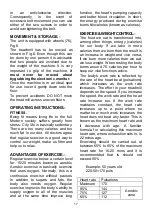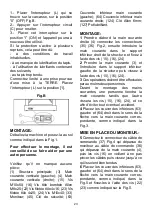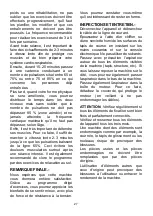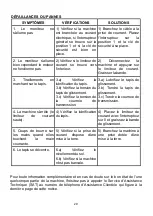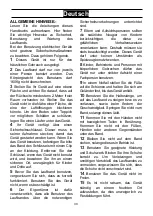
17
in
an
anticlockwise
direction.
Consequently, in the event of
excessive belt movement you can use
either of the two screws in order to
avoid overtightening the belt.
MOVEMENT & STORAGE.-
The unit is equipped with wheels (76),
Fig.6
The treadmill has to be moved as
shown in Fig.6. Even though this can
be done by one person it is advisable
that two people are involved due to
the weight of the machine. It is very
important to grip of the machine,
it
must never be moved about
bygrabbing the electronic monitor.
Once the machine is in an ideal spot
for use, lower it gently down onto the
floor.
To prevent accidents DO NOT move
the treadmill across uneven floors.
OPERATING INSTRUCTIONS.-
FITNESS.
Being fit means living life to the full.
Modern society suffers greatly from
stress. City life is basically sedentary.
There are too many calories and too
much fat in our diet. All doctors agree
that regular exercise is a good way to
control our weight, make us fitter and
help us to relax.
ADVANTAGES OF EXERCISE.-
Regular exercise below a certain level
for 15/20 minutes becomes aerobic.
Aerobic exercise is basically exercise
that uses oxygen. Normally, this is a
continuous exercise without pauses.
In addition to sugars and fats, the
body also needs oxygen. Regular
exercise improves the body’s ability to
supply oxygen to all of the muscles
and at the same time improve lung
function, the heart’s pumping capacity
and better blood circulation. In short,
the energy produced during exercise
burns kilocalories (known as calories).
EXERCISE & WEIGHT CONTROL.-
The food we eat is transformed into,
among other things, energy (calories)
for our body. If we take in more
calories than we burn then the result is
an increase in weight and vice versa,
if we burn more calories than we eat,
we lose weight. When resting the body
burns around 70 calories per hour to
keep our vital functions active.
The body’s work rate is reflected by
the rate of the heart beat (pulsations)
which increases as the work rate
increases. The effort in your treadmill
depends on the speed. If you increase
the speed, the work rate and the heart
rate increase too. If the work rate
maintains constant, the heart rate
increases up to a point where no
matter how much work increases the
heart does not beat any faster. This is
known as the maximum heart rate and
it decrease with age. A familiar
formula for calculating this maximum
heart rate, where exhaustion sets in, is
22 minus age.
Exercising should be carried out at
between 65% to 85% of the maximum
heart rate for 15-20 mins and it is
recommentded that is should not
exceed 85%.
Example: 50 years old
220-50=170 puls
Heart rate
Pulsations
Maximum
170
85%
144
Aerobic
zone
75%
127
65%
112
Summary of Contents for 3218219
Page 2: ...2 Fig 1 Fig 2 Fig 3...
Page 3: ...3 Fig 4 Fig 5 Fig 6 Fig 7 Fig 8...
Page 66: ...G6182i 02...
Page 69: ...G6182TFT...















